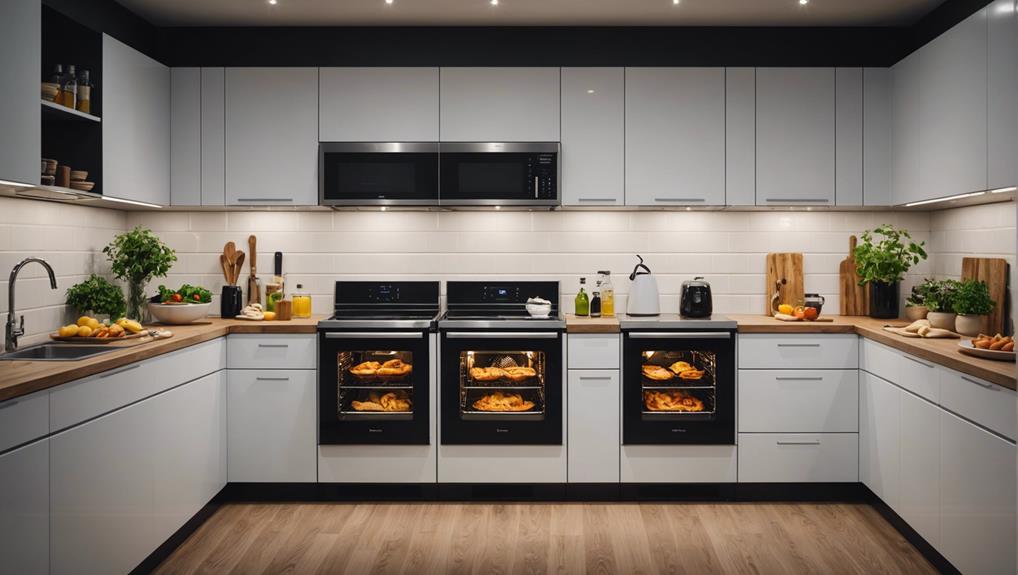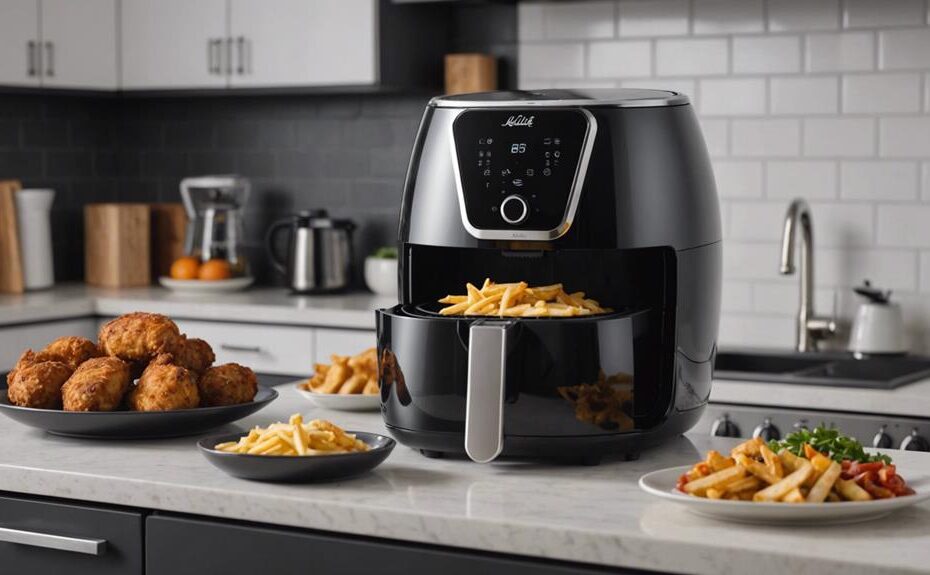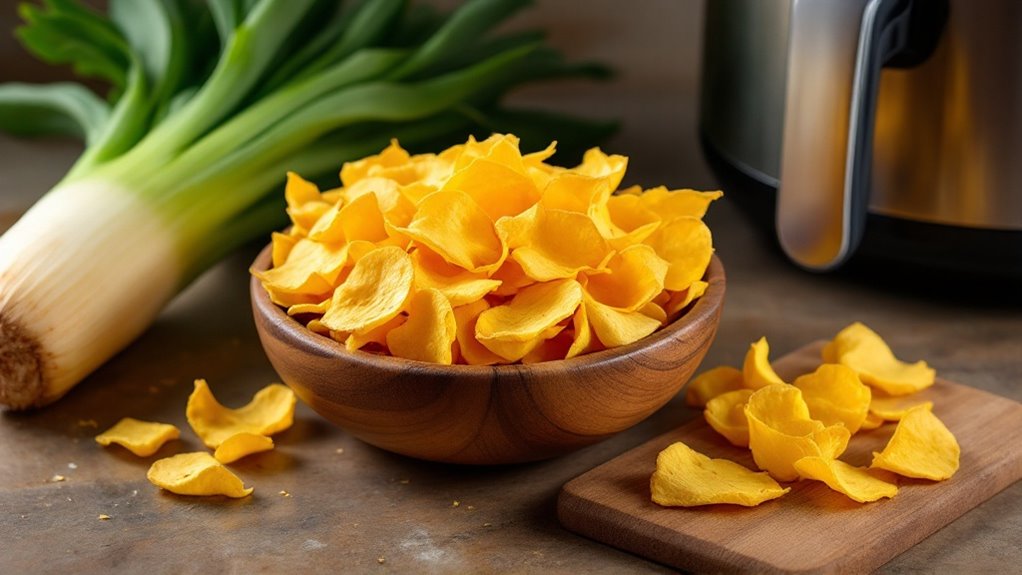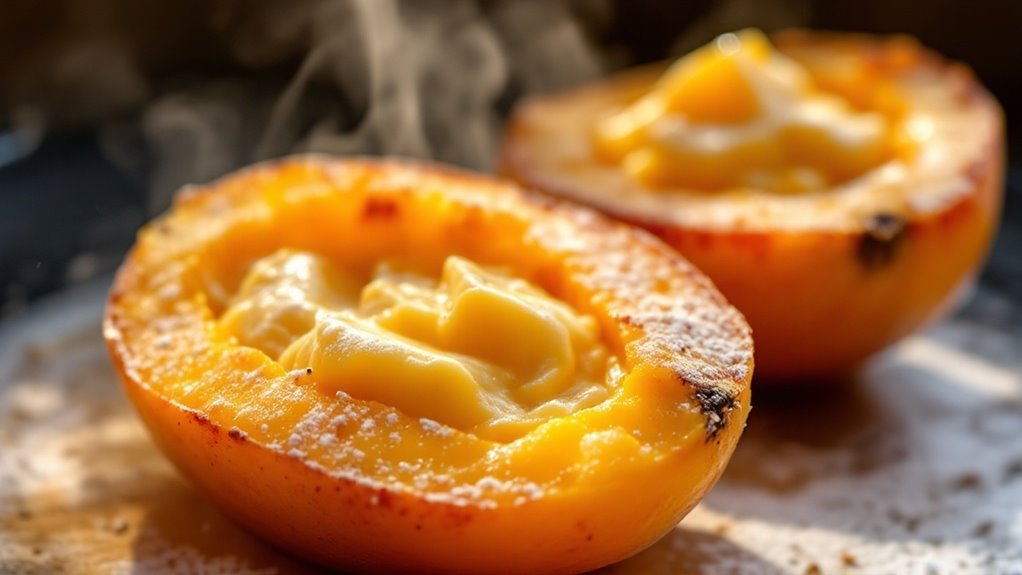Air fryers typically consume between 800 to 2,000 watts, with smaller models using 800 to 1,200 watts and larger units requiring 1,500 to 2,000 watts. This energy consumption translates to approximately 25 cents per hour of operation. They're more energy-efficient compared to traditional ovens, which use 2,000 to 5,000 watts. By utilizing circulating hot air technology, air fryers not only cook faster but also save up to 50% on energy costs. Factors like cooking time, temperature, and unit size impact overall electricity usage. To understand how you can optimize your air fryer's energy efficiency, explore further.
Key Takeaways
- Air fryers typically use between 800 to 2,000 watts, depending on the model size.
- Smaller air fryers consume around 800 to 1,200 watts, while larger ones need 1,500 to 2,000 watts.
- Using the formula Amps = Watts / Voltage helps determine the amperage of the air fryer.
- Air fryers offer up to 50% energy savings compared to traditional ovens due to faster cooking times.
- Operating an air fryer costs approximately 25 cents per hour, contributing to lower electricity bills.
Air Fryer Wattage
Understanding air fryer wattage is vital as it directly impacts the appliance's energy consumption and overall efficiency. Air fryers typically operate within a range of 800 to 2,000 watts. Smaller models usually consume between 800 and 1,200 watts, while larger ones require 1,500 to 2,000 watts. The specific wattage of your air fryer will determine its electricity consumption and, consequently, its energy efficiency.
To calculate the amps your air fryer uses, apply the formula:; Amps = Watts / Voltage. For instance, if your air fryer operates at 1,200 watts and runs on a standard U.S. voltage of 120 volts, it draws approximately 10 amps. This data is essential when considering the compatibility of your device with household circuits or portable power stations, especially for off-grid usage.
Cooking times and frequency also affect energy usage. An air fryer that cooks food faster at higher wattage might use more power in short bursts but could be more energy-efficient overall. Conversely, a lower-wattage air fryer may require longer cooking times, potentially increasing electricity consumption. Therefore, understanding these parameters helps you optimize both power usage and cooking efficiency, leading to more informed appliance choices.
Size and Energy Usage
When evaluating the size and energy usage of air fryers, it's important to recognize that the physical dimensions of the appliance don't greatly impact its electricity consumption. Instead, the energy use is more closely tied to the cooking time and the power consumption of the device. Larger air fryers might seem like they would use more electricity, but this isn't necessarily the case. Their power consumption primarily depends on the duration and intensity of the cooking process.
Energy-efficient models are designed to minimize electricity consumption, making them a smart choice if you're looking to save on electricity costs. Proper sizing of the air fryer relative to the amount of food being cooked is essential for optimizing energy efficiency. If you're cooking for a large group, a single larger batch will generally be more efficient than multiple smaller batches, which would increase total cooking time and power usage.
Moreover, while higher-powered air fryers can complete cooking tasks more quickly, they may also consume more electricity in shorter bursts. Balancing the power rating with your specific cooking needs can help you manage overall energy use effectively. By considering these factors, you can better understand how to maximize efficiency and minimize costs with your air fryer.
Air Fryer Vs. Oven

Air fryers, consuming between 800 to 1800 watts of power, are considerably more energy-efficient than traditional electric ovens, making them a cost-effective choice for cooking. When you use an oven, it typically draws between 2000 to 5000 watts, much more electricity than a fryer. This difference in energy use translates to substantial savings in your electricity bill.
Large air fryers, despite their increased capacity, still maintain an advantage in energy efficiency. They use circulating hot air technology to cook food quickly and evenly, reducing cooking times by up to 30% compared to ovens. This rapid cooking minimizes energy consumption, making fryers a cost-effective choice for energy-conscious households.
In terms of cooking performance, fryers excel due to their compact size and efficient heat distribution. While ovens take longer to preheat and cook, air fryers are ready almost instantly, leading to quicker meal preparation. Over time, the lower energy use of a fryer can result in energy savings of up to 50% compared to using an oven.
Consider both the initial purchase price and the long-term energy savings when deciding between an air fryer and an oven. The overall energy efficiency and cost-effectiveness of air fryers make them a smart choice for modern cooking.
Reducing Energy Use
To maximize the energy efficiency of your air fryer, preheating it before cooking can greatly reduce overall cooking time and energy consumption. By making sure the air fryer reaches the desired temperature before placing food inside, you can not only shorten the cooking duration but also reduce your carbon footprint. A shorter overall cooking time translates to less electricity consumption, which is important for energy efficiency.
Using the correct settings for different food types is another way to optimize energy usage. Each type of food may require specific temperature and time settings to cook efficiently. Incorrect settings can lead to extended cooking times and higher electricity consumption. Additionally, avoid opening the air fryer door during cooking to maintain temperature stability. Frequent openings cause heat loss, requiring the device to consume more energy to regain the set temperature.
Unplugging the air fryer when not in use can save on standby power, further reducing electricity consumption. Properly sizing the air fryer for the amount of food being cooked also helps minimize energy waste. An appropriately sized air fryer ensures that the heat is distributed efficiently, optimizing energy usage and maintaining temperature effectively.
Factors Influencing Consumption

Understanding the specific factors that influence your air fryer's electricity consumption can help you make more informed decisions about its use. Key elements impacting power consumption include wattage, cooking settings, and the duration of use. Air fryers typically use between 800 to 2,000 watts, with smaller models consuming 800-1,200 watts and larger units drawing 1,500-2,000 watts. Hence, the size of your air fryer directly affects its energy consumption.
Cooking settings also play an important role. Higher cooking temperatures and extended cooking durations increase electricity usage. For example, frying at 400°F will consume more power compared to 350°F due to the energy required to maintain higher temperatures. Monitoring and adjusting these settings can greatly enhance energy efficiency.
Moreover, the frequency and duration of use are pivotal. Regular, prolonged usage naturally leads to higher cumulative energy consumption. To mitigate this, consider complementary renewable energy sources if you frequently use larger air fryers.
Cost Savings
Switching to an air fryer can lead to substantial cost savings, with users potentially cutting their energy expenses by up to 50% compared to traditional ovens. This energy efficiency translates directly into lower electricity bills. On average, an air fryer costs about 25 cents per hour to operate, greatly reducing your utility bills over time.
When you consider the frequency of use and cooking time, the cost savings become apparent. Traditional ovens typically consume more electricity because they take longer to preheat and cook food. In contrast, air fryers heat up quickly and cook food faster, leading to reduced electricity usage. Over the course of a year, these savings can add up to hundreds of dollars off your utility bills.
Moreover, the cost efficiency of air fryers isn't just limited to lower electricity bills. They contribute to a reduced carbon footprint, making them an environmentally friendly choice. By cutting energy costs and reducing overall electricity usage, you're not only saving money but also making a positive impact on the environment. With long-term savings and energy efficiency, air fryers offer a smart, cost-effective alternative to traditional cooking methods.
Frequently Asked Questions
Is It Cheaper to Use an Air Fryer Than an Oven?
Yes, it's cheaper to use an air fryer than an oven. Its energy efficiency, faster cooking time, and better heat distribution reduce power consumption. Plus, frequent usage, meal versatility, and longer appliance lifespan enhance overall user experience and nutritional benefits.
Why Are People Getting Rid of Air Fryers?
You're ditching air fryers due to health concerns, counter space issues, noise levels, cooking smell, maintenance problems, limited capacity, recipe limitations, and overhyped appliance claims. Cleaning difficulty and durability concerns also make them less appealing.
What Uses More Power, a Microwave or an Air Fryer?
Comparing power usage, microwaves generally consume more energy than air fryers due to higher wattage variations and longer cooking durations. Air fryers offer better energy efficiency, meal versatility, and often require less preheating time, enhancing food quality.
How Much Does It Cost to Run an Air Fryer for 30 Minutes?
You'll find running an air fryer for 30 minutes costs around 8 to 15 cents. Factors like wattage rating, utility rates, and usage frequency affect power usage. For better cooking efficiency, consider appliance efficiency and energy-saving tips.
Conclusion
In your quest for efficient cooking, think of the air fryer as a sleek sports car. With wattage typically ranging from 800 to 1500 watts, it outpaces traditional ovens in energy savings. By considering size, usage habits, and optimization techniques, you navigate the road to reduced energy costs. The result? A more sustainable kitchen, where every meal cooked is a step toward energy efficiency and financial prudence. Your culinary journey now has the perfect co-pilot.
Disclosure: As an Amazon Associate, I earn from qualifying purchases.



